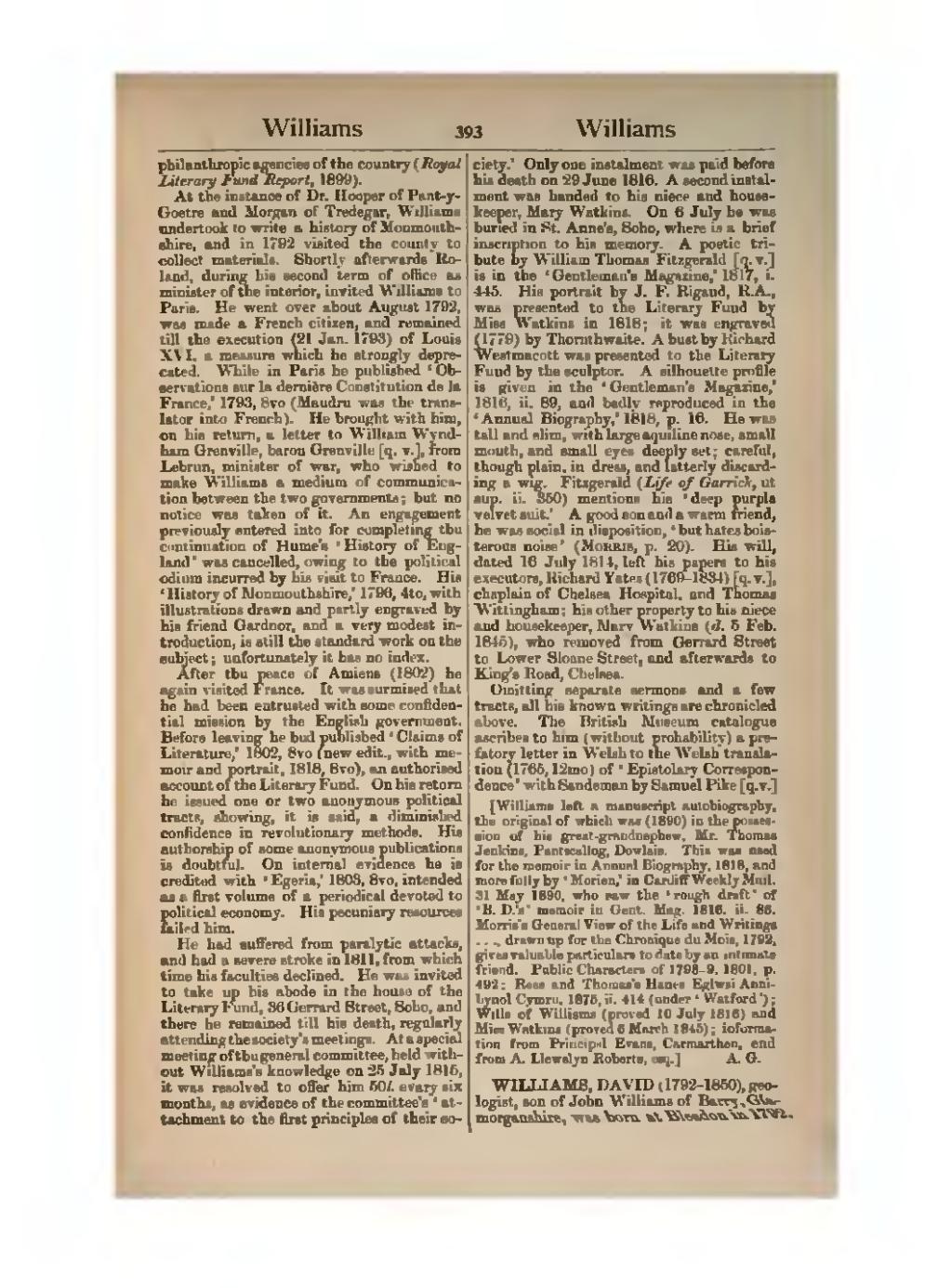philanthropic agencies of the country (Royal Literary Fund Report, 1899).
At the instance of Dr. Hooper of Pant-y-Goetre and Morgan of Tredegar, Williams undertook to write a history of Monmouthshire, and in 1792 visited the county to collect materials. Shortly afterwards Roland, during his second term of office as minister of the interior, invited Williams to Paris. He went over about August 1792, was made a French citizen, and remained till the execution (21 Jan. 1793) of Louis XVI, a measure which he strongly deprecated. While in Paris he published ‘Observations sur la dernière Constitution de la France,’ 1793, 8vo (Maudru was the translator into French). He brought with him, on his return, a letter to William Wyndham Grenville, baron Grenville [q. v.], from Lebrun, minister of war, who wished to make Williams a medium of communication between the two governments; but no notice was taken of it. An engagement previously entered into for completing the continuation of Hume's ‘History of England’ was cancelled, owing to the political odium incurred by his visit to France. His ‘History of Monmouthshire,’ 1796, 4to, with illustrations drawn and partly engraved by his friend Gardnor, and a very modest introduction, is still the standard work on the subject; unfortunately it has no index.
After the peace of Amiens (1802) he again visited France. It was surmised that he had been entrusted with some confidential mission by the English government. Before leaving he had published ‘Claims of Literature,’ 1802, 8vo (new edit., with memoir and portrait, 1816, 8vo), an authorised account of the Literary Fund. On his return he issued one or two anonymous political tracts, showing, it is said, a diminished confidence in revolutionary methods. His authorship of some anonymous publications is doubtful. On internal evidence he is credited with ‘Egeria,’ 1803, 8vo, intended as a first volume of a periodical devoted to political economy. His pecuniary resources failed him.
He had suffered from paralytic attacks, and had a severe stroke in 1811, from which time his faculties declined. He was invited to take up his abode in the house of the Literary Fund, 36 Gerrard Street, Soho, and there he remained till his death, regularly attending the society's meetings. At a special meeting of the general committee, held without Williams's knowledge on 25 July 1815, it was resolved to offer him 50l. every six months, as evidence of the committee's ‘attachment to the first principles of their society.’ Only one instalment was paid before his death on 29 June 1816. A second instalment was handed to his niece and housekeeper, Mary Watkins. On 6 July he was buried in St. Anne's, Soho, where is a brief inscription to his memory. A poetic tribute by William Thomas Fitzgerald [q. v.] is in the ‘Gentleman's Magazine,’ 1817, i. 445. His portrait by J. F. Rigaud, R.A., was presented to the Literary Fund by Miss Watkins in 1818; it was engraved (1779) by Thornthwaite. A bust by Richard Westmacott was presented to the Literary Fund by the sculptor. A silhouette profile is given in the ‘Gentleman's Magazine,’ 1816, ii. 89, and badly reproduced in the ‘Annual Biography,’ 1818, p. 16. He was tall and slim, with large aquiline nose, small mouth, and small eyes deeply set; careful, though plain, in dress, and latterly discarding a wig. Fitzgerald (Life of Garrick, ut sup. ii. 350) mentions his ‘deep purple velvet suit.’ A good son and a warm friend, he was social in disposition, ‘but hates boisterous noise’ (Morris, p. 20). His will, dated 16 July 1814, left his papers to his executors, Richard Yates (1769–1834) [q. v.], chaplain of Chelsea Hospital, and Thomas Wittingham; his other property to his niece and housekeeper, Mary Watkins (d. 5 Feb. 1845), who removed from Gerrard Street to Lower Sloane Street, and afterwards to King's Road, Chelsea.
Omitting separate sermons and a few tracts, all his known writings are chronicled above. The British Museum catalogue ascribes to him (without probability) a prefatory letter in Welsh to the Welsh translation (1765, 12mo) of ‘Epistolary Correspondence’ with Sandeman by Samuel Pike [q. v.]
[Williams left a manuscript autobiography, the original of which was (1890) in the possession of his great-grandnephew, Mr. Thomas Jenkins, Pantscallog, Dowlais. This was used for the memoir in Annual Biography, 1818, and more fully by ‘Morien,’ in Cardiff Weekly Mail, 31 May 1890, who saw the ‘rough draft’ of ‘B. D.'s’ memoir in Gent. Mag. 1816, ii. 86. Morris's General View of the Life and Writings …, drawn up for the Chronique du Mois, 1792, gives valuable particulars to date by an intimate friend. Public Characters of 1798–9, 1801, p. 492; Rees and Thomas's Hanes Eglwsi Annibynol Cymru, 1875, ii. 414 (under ‘Watford’); Wills of Williams (proved 10 July 1816) and Miss Watkins (proved 6 March 1845); information from Principal Evans, Carmarthen, and from A. Llewelyn Roberts, esq.]
WILLIAMS, DAVID (1792–1850), geologist, son of John Williams of Barry, Glamorganshire, was born at Bleadon in 1792.
